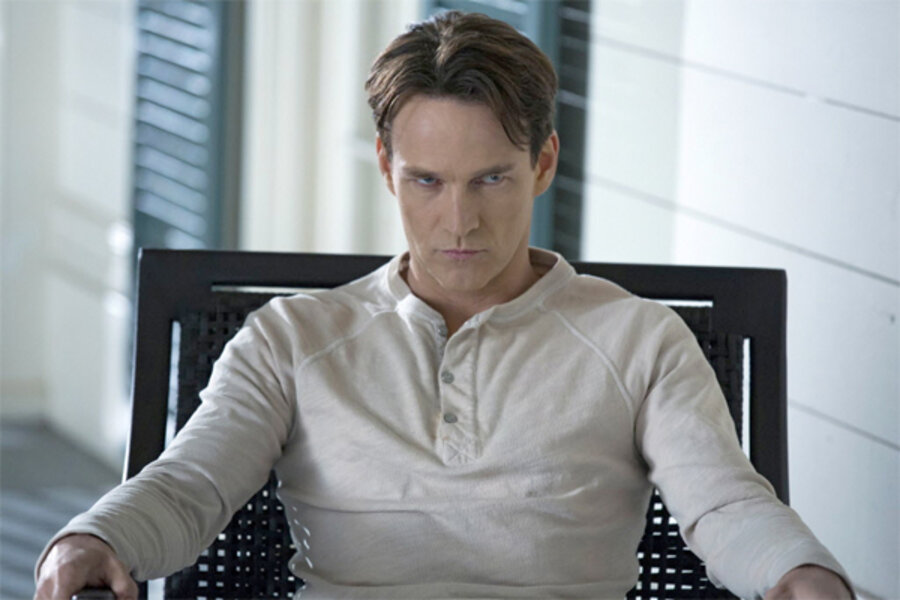'True Blood': Did season premiere solve show's problem of juggling too many storylines?
The intent of this episode is to find who or what Bill (Stephen Moyer) is now but the actual story and its focus is, as one now expects from this series, unnecessarily complex and disorganized, so much so that the question it’s looking to answer is once again muddied by the relentless, unforgiving nature of the numerous storylines that True Blood attempts (and mostly fails) to juggle simultaneously. But even though the mess of plots and subplots continuously to feel unnecessary, as if it’s a weakness of the series, there’s something about this amalgamation which tempts you to tune in, year after year, episode after episode – and season 6 is no different.
The premiere picks up where the True Blood season 5 finale left off, with Sookie (Anna Paquin) and company escaping from the Vampire Authority as Billith was born from blood. This, itself, is a bit of a conundrum for those tuning in, as you’re required to piece together fragmented memories from over a year ago in order to understand what’s going on. This has largely been the case since True Blood began, but since season 5 and season 6 storylines are essentially one, being able to remember everything from last season is now a bit of an unfortunate necessity. And though the series has been on the air for six years now, it seems as if you need to continuously remind yourself that this show is, for all intents and purposes, a vampiric soap opera, as season 1 was the only time the series could have been considered a streamlined drama.
Still, True Blood keeps pushing forward, moving more and more away from the source material, into whatever theoretically logical storyline can hopefully encase its enormous – and ever-growing – cast of characters. Now it’s time to witness the return of Warlow (canonically speaking); the shortage of Tru Blood; the reign (or lack thereof) of Billith; humanity’s turn on vampire allegiances; Andy Bellefleur’s (Chris Bauer) rapidly growing fairy children; and Sam Merlot’s (Sam Trammell) single father woes – and that’s just in the premiere episode, where no story really feels fully serviced.
But with longtime series scribe Brian Buckner taking over as showrunner for season 6, and Raelle Tucker, who penned the terrific season 1 finale, taking on the first episode of the season, there’s a real reason to be intrigued and excited about what the premiere, as well as the season, has in store for its characters. Such encouraging and hopeful feelings are quickly squashed, though, as True Blood finally reveals itself for what it is: a self-working machine, where writers and directors are really only there to continue progressing what’s already been established. Typically, what’s already been established would be series formatting, character personalities, visual styles, etc. But in the case of True Blood, what’s already been established is its proverbial cornucopia of characters stories, with an open-ended seasonal storyline to boot.
Now that’s not to say that what True Blood currently is, in and of itself, is a bad thing, but it does limit the avenues that creative minds, like Tucker, are able to take with their given episodes. Additionally, with the episode count being cut from 12 episodes to 10, the inherent structure in which Tucker, as well as every other writer on the show, are typically used to have shifted, so there is a 2-episode storytelling gap that needs to be filled, even if many believe there’s already too much storytelling going on already.
What we’re left with, essentially, is a “ball” that’s been rolling for quite some time, and the only thing Tucker can do is maintain the series with the season 6 premiere – but, again, that’s not necessarily a bad thing. As True Blood has aged, it’s the supplemental characters, like Eric (Alexander Skarsgård), Pam (Kristin Bauer van Straten) and, yes, Lafayette (Nelsan Ellis), that have risen to the top, as their characters have the weight and intensity to break through the melodrama of its main characters, to consistently elevate each scene beyond its operatic structure. But at the same time, characters like Terry have, sadly, been pushed aside and are now used as a comic relief or, like with Alcide, are given completely unenticing storylines to follow.
At six years of age, True Blood has already defined itself as a series, so any complaints of its complicated, disorganized structure are a bit of a moot point, and there’s no real opportunity for anyone – even the showrunner – to change that. And it shouldn’t change, really.
Because no matter how numerous or ridiculous the storylines, no matter how operatic the series itself is, there’s an undeniable allure to its madness which leads you to continue tuning in. There’s a reason why soap operas were so successful on television for so long, and True Blood has, for better or worse, successfully made use of such elements. Will this be one of the best seasons of television you’ve seen? Not likely. But you’ve got to give credit to a series that can get you to watch it on its terms where even if, at times, you’re frustrated, you’ll tune in next week.
Anthony Ocasio blogs at Screen Rant.





